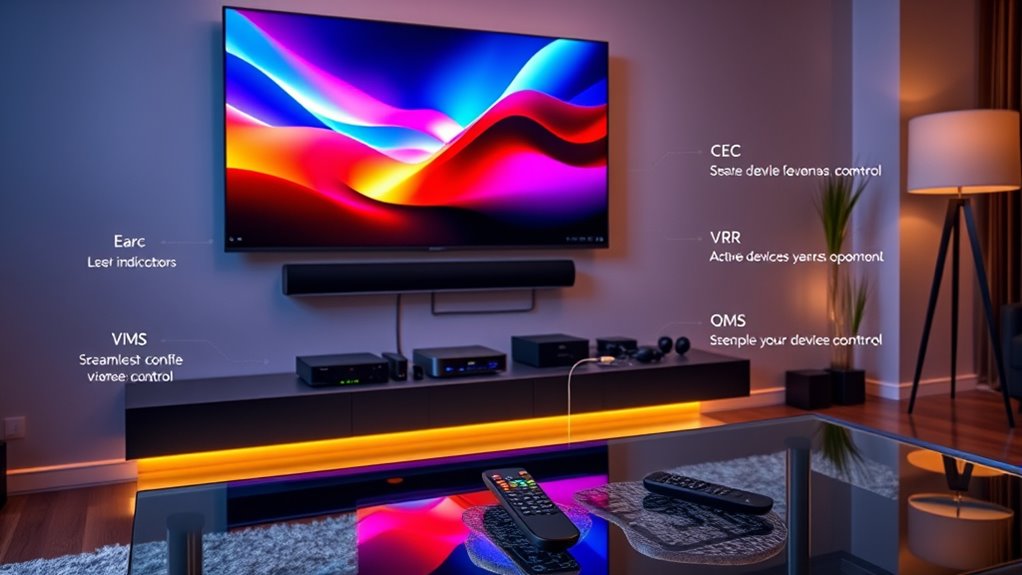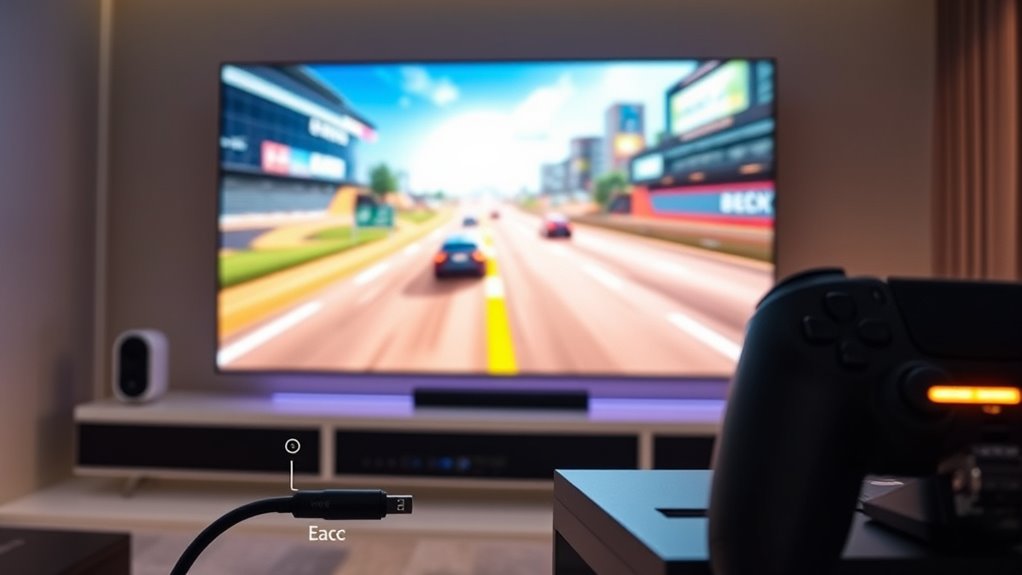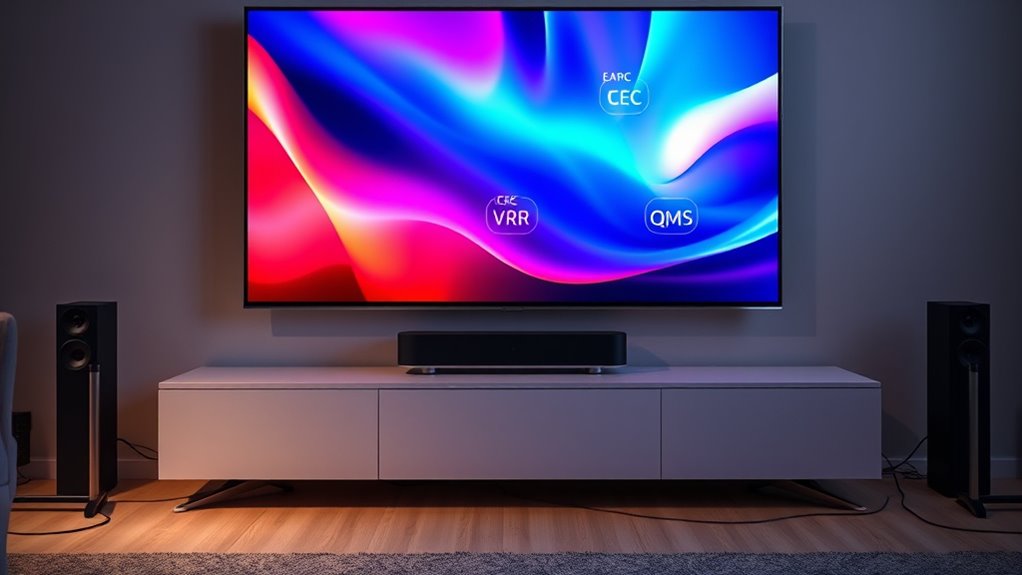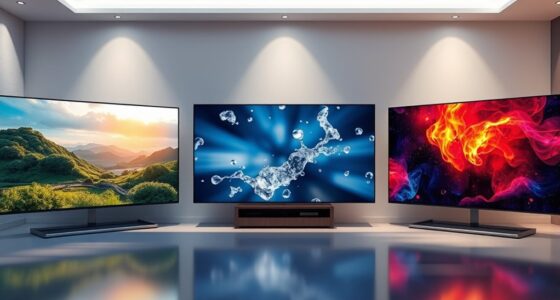Home theater sync involves several key technologies working together. eARC delivers high-quality, uncompressed audio formats like Dolby Atmos via HDMI. CEC allows your devices to communicate and control each other with one remote. VRR synchronizes your display’s refresh rate with content for smooth gameplay, while QMS switches sources instantly without delays. Combining these guarantees synchronized, seamless audio and video. Stay tuned to discover how these features enhance your home entertainment experience even more.
Key Takeaways
- eARC transmits high-quality, uncompressed audio formats like Dolby Atmos over HDMI for immersive sound in home theaters.
- CEC enables remote control of multiple connected devices via a single remote, simplifying user experience.
- VRR synchronizes the display’s refresh rate with the source’s frame rate, reducing tearing and stuttering during fast-paced scenes.
- QMS allows instant switching between HDMI sources with different frame rates, avoiding black screens or flicker.
- These technologies collectively enhance audio-video synchronization, picture quality, and user convenience in home theater setups.
Understanding Earc and Its Role in High-Quality Audio

Understanding eARC is essential if you want to experience high-quality audio from your home theater system. eARC, or Enhanced Audio Return Channel, allows your TV to send uncompressed, immersive sound formats like Dolby Atmos and DTS:X directly to your soundbar or AV receiver through a single HDMI cable. This means you get richer, more detailed audio without extra connections or complicated setups. Unlike traditional ARC, eARC supports higher bandwidth, enabling the transmission of advanced audio formats without compression. To enjoy these benefits fully, both your TV and audio device need HDMI 2.1 ports compatible with eARC. Once set up, you’ll notice clearer dialogue, more precise sound placement, and an overall more immersive listening experience that elevates your home theater. Additionally, high refresh rates can improve lip-sync and reduce latency, enhancing both audio and video synchronization for a seamless experience. Moreover, ensuring your devices support HDMI 2.1 specifications guarantees optimal performance and future-proofing for your home theater setup. Incorporating audio formats with your setup allows for a broader range of sound experiences and compatibility. Furthermore, understanding audio return channels can help you troubleshoot connectivity issues and optimize your audio setup.
How HDMI-CEC Enhances Device Control and User Experience

HDMI-CEC simplifies your home theater setup by allowing all connected devices to communicate and be controlled through a single remote. With CEC, you can turn on your TV, soundbar, and Blu-ray player simultaneously, and the devices will automatically recognize each other. Adjusting the volume on your remote will control the sound system directly, eliminating multiple remotes. Features like one-touch play and system standby make managing your setup effortless. CEC also syncs device functions, so switching inputs or powering down updates all connected gear at once. This seamless control reduces clutter and manual switching, creating a smoother, more intuitive user experience. Additionally, understanding AI ethics can help consumers make informed choices about the smart devices they incorporate into their entertainment systems. Ensuring all devices have compatible quality assurance standards is essential for consistent performance and reliable operation of CEC features. Proper implementation of device interoperability standards ensures that your devices work harmoniously, preventing connectivity issues and enhancing overall reliability. Moreover, staying aware of future technology developments can help you keep your home theater system up-to-date and fully functional. Being mindful of cybersecurity risks associated with connected devices can also protect your setup from potential vulnerabilities.
The Benefits of VRR for Gaming and Fast-Moving Content

Variable Refresh Rate (VRR) technology substantially enhances your gaming and fast-moving video experiences by syncing the display’s refresh rate with the frame rate of your source device. This synchronization reduces screen tearing, which happens when frames don’t align perfectly, causing distracting visual glitches. It also minimizes stuttering and judder, delivering smoother motion during rapid on-screen movements. As a result, gameplay becomes more fluid, with improved responsiveness and less input lag. You’ll notice a more immersive experience, especially in fast-paced genres like shooters, racing, and action games. VRR also benefits high-motion video playback, ensuring scenes look clear and stable even when the content involves quick camera movements or rapid scene changes. Additionally, understanding AI Bifurcation can help consumers and industry professionals better anticipate future technological shifts in content creation and display optimization. Incorporating adaptive technologies can further optimize your visual experience by dynamically adjusting settings based on content type and performance needs. Furthermore, understanding content synchronization principles can provide insights into how hardware and software work together to deliver seamless playback. Moreover, being aware of asset division principles can provide insights into how different components of a display system are valued and allocated, influencing future hardware development. Recognizing the importance of home decor in creating an optimal environment can also enhance your overall entertainment setup, making the viewing experience even more enjoyable. Overall, VRR makes your gaming and fast-moving content look sharper, more consistent, and more enjoyable.
Quick Media Switching: Seamless Transitions Between Sources

Switching between different HDMI sources can sometimes cause frustrating delays or blank screens, disrupting your viewing experience. Quick Media Switching (QMS) solves this problem by enabling faster changes between sources with varying frame rates, like switching from a 24Hz movie to a 60Hz TV show. It works by quickly adjusting the display’s timing to match the new source, preventing the typical black screen or flicker during switching. Supported in HDMI 2.1 devices, QMS ensures seamless, immediate transitions, keeping your home theater immersive and uninterrupted. To get the benefits, both your source device and display need to support QMS. When set up correctly, it makes switching between content smooth and instant, enhancing your overall viewing comfort without distracting delays. Additionally, understanding the frame rate compatibility between your devices can further optimize your viewing experience. Ensuring compatibility with home theater standards can improve overall performance and support features like QMS more effectively. Moreover, being aware of video processing capabilities can help you fine-tune settings for the best possible picture quality during source transitions. Recognizing the importance of energy-efficient technologies can also contribute to a more sustainable and cost-effective home theater setup. Incorporating device interoperability principles can further streamline your system for better overall performance.
Wireless Audio Synchronization With Wisa Technology

Wireless audio synchronization with Wisa technology lets you stream multi-channel sound without cables, keeping your home theater tidy and flexible. Its ultra-low latency streaming guarantees audio stays perfectly in sync with video, so you won’t notice any delays. This seamless integration makes it easy to create a connected, immersive audio experience throughout your space. Additionally, vetted home theater projectors can enhance your setup by providing high-quality visuals that complement your synchronized audio system. For optimal performance, ensure your headphones or speakers are compatible with Bluetooth or wireless standards, which can improve connectivity and reduce latency issues. Properly maintaining your audio equipment can also help sustain consistent performance over time. By understanding wireless audio standards, you can better select compatible devices and improve your overall home theater experience.
Wireless Multi-Channel Audio
Wireless multi-channel audio using WISA technology enables seamless, synchronized sound across multiple speakers without the clutter of cables. You can create a true surround sound experience by connecting up to eight channels of high-resolution audio, such as Dolby Atmos or DTS:X, with precision timing of ±2 microseconds. Imagine:
- Multiple speakers working together, delivering immersive, consistent sound in every corner.
- Audio delay as low as 2.6 milliseconds at 96 kHz, making dialogue and effects perfectly synchronized.
- A clean setup without the need for cumbersome wiring, ideal for maintaining aesthetics and flexibility.
- This technology supports holistic approaches to sound design, enhancing overall home theater immersion. Additionally, system integration allows for easier setup and control within your existing home entertainment ecosystem.
This setup ensures your home theater sounds as good as it looks, with synchronized audio that moves seamlessly across speakers, enhancing your listening experience.
Ultra-Low Latency Streaming
Ultra-low latency streaming with WISA technology guarantees that your home theater audio remains perfectly synchronized across multiple speakers, even during high-intensity scenes. WISA achieves this by transmitting wireless audio with a synchronization accuracy of ±2 microseconds, ensuring all speakers play in perfect harmony. It supports up to eight channels of high-resolution 24-bit/96 kHz audio, including immersive formats like Dolby Atmos. The technology’s low delay rate of around 2.6 milliseconds means you won’t notice any lip-sync issues or lag, maintaining seamless sound movement. Designed for devices without external antennas, WISA works well with soundbars, speakers, and TVs in nonmetallic enclosures. This ensures a reliable, synchronized wireless setup that elevates your home theater experience without the clutter of cables.
Seamless Home Integration
To achieve a truly seamless home theater experience, you need reliable audio synchronization across all your speakers. Wisa technology makes this possible wirelessly, guaranteeing your sound remains tight and cohesive. It supports up to eight channels of high-quality audio, including immersive formats like Dolby Atmos. With a precision of ±2 microseconds, your speakers stay perfectly in sync, preventing delays or echo effects. Imagine these benefits:
- Wireless streaming of multi-channel audio without lag or dropout.
- Compatibility with various devices, from soundbars to in-wall speakers.
- Easy setup, reducing clutter and eliminating the need for extensive wiring.
Wisa’s low latency and high fidelity make it ideal for maintaining a consistent, immersive soundstage across your entire home theater. This technology ensures your audio is seamless, synchronized, and ready for the best possible experience.
Leveraging Acoustic Center Sync and Q-Symphony for Better Sound

Leveraging Acoustic Center Sync and Q-Symphony can considerably enhance your home theater audio experience by seamlessly integrating your TV’s built-in speakers with a compatible soundbar. This technology allows the TV’s speakers to act as the center channel, providing clearer dialogue and a fuller soundstage without extra wiring. Q-Symphony synchronizes the soundbar with your TV’s speakers, ensuring audio plays in perfect harmony. You’ll notice improved clarity, especially during dialogue-heavy scenes, making conversations more intelligible. This setup simplifies your system by combining the TV’s speakers with external audio devices, creating a more immersive environment. Compatibility depends on having a Sony BRAVIA TV and a soundbar supporting these features, but once configured, your home theater will deliver richer, more cohesive sound effortlessly.
Compatibility and Setup: Ensuring Your Devices Work Together

Ensuring your devices work seamlessly together starts with checking their compatibility. First, verify that your TV and audio system support HDMI 2.1, especially for eARC and QMS features. Second, ensure all HDMI cables are HDMI-High Speed or Ultra High Speed, compatible with CEC and VRR functions. Third, confirm that your connected devices, like gaming consoles and media players, support the features you want, such as VRR or QMS. This might involve updating firmware or enabling specific settings in menus. Proper compatibility prevents issues like audio dropouts, delays, or no picture when switching sources. Taking these steps ensures smooth communication between devices, leading to a more integrated and hassle-free home theater experience. Always consult device manuals for specific compatibility requirements.
Future Trends in Home Theater Connectivity

Future home theater connectivity will likely see smarter device integration powered by AI, making setup and control more intuitive. Wireless advancements will continue to reduce cables while improving stability and audio-visual quality. Additionally, user interfaces will become more streamlined, offering seamless, personalized experiences across all your devices.
AI-Driven Device Integration
AI-driven device integration is transforming home theater connectivity by enabling seamless, intelligent communication between your devices. It automates setup, predicts your preferences, and adjusts settings in real-time, creating a more intuitive experience. You’ll notice this through:
- Smart device pairing — your TV, soundbar, and gaming console connect automatically, recognizing each other and configuring settings without manual input.
- Adaptive performance — AI detects content type and optimizes audio and video quality instantly, enhancing immersion.
- Predictive troubleshooting — issues are identified and resolved proactively, reducing downtime and frustration.
This technology simplifies complex setups, eliminates the need for constant manual adjustments, and guarantees your home theater system adapts dynamically to your viewing habits for a truly intelligent entertainment experience.
Wireless Connectivity Advancements
Wireless connectivity in home theater systems is rapidly advancing, making it easier than ever to create a clutter-free setup. New wireless standards like WiSA enable high-quality, multi-channel audio streaming with near-perfect synchronization, eliminating the need for cumbersome cables. This technology supports Dolby Atmos and DTS:X, delivering immersive sound without wiring constraints. Additionally, improvements in Wi-Fi 6 and future Wi-Fi 7 standards boost streaming stability, speed, and latency, ensuring seamless content playback. Wireless HDMI solutions are also emerging, allowing high-definition video transfer without physical cables. These advancements mean you can position speakers and devices more flexibly, simplify installation, and reduce clutter. As wireless tech continues evolving, expect even more reliable, high-performance connections that enhance your home theater experience while maintaining a clean, modern aesthetic.
Enhanced User Interface Design
As home theater systems become more sophisticated with wireless connections and advanced audio formats, managing and controlling these devices needs to become simpler and more intuitive. Future trends focus on enhanced user interface design to streamline your experience. You’ll see:
- Unified control apps that let you manage all devices from a single interface, reducing remote clutter.
- Voice-activated commands integrated with AI assistants for effortless device adjustments and content searches.
- Adaptive menus that learn your preferences, displaying relevant options and minimizing navigation steps.
These innovations aim to make setup, operation, and troubleshooting faster and more natural. By combining sleek visuals with intelligent features, your home theater becomes more accessible, ensuring you enjoy immersive entertainment without frustration or confusion.
Frequently Asked Questions
Can I Use Earc With Older HDMI Devices?
You can’t use eARC with older HDMI devices because eARC requires HDMI 2.1 ports, which older devices don’t have. If your devices only support HDMI 2.0 or earlier, they’ll be limited to ARC or standard HDMI functionality. To enjoy eARC’s high-quality audio features, you’ll need compatible devices and cables that support HDMI 2.1. Otherwise, you won’t get the full benefits of eARC’s advanced audio capabilities.
How Do I Enable HDMI-CEC on My TV and Devices?
Think of your devices as a choir needing coordination. To enable HDMI-CEC, navigate your TV’s menu to find the settings labeled “HDMI Control,” “CEC,” or similar. Turn it on, then do the same for each connected device, ensuring CEC is enabled there too. Save your settings, and your devices will now communicate seamlessly, harmonizing your home theater experience without the hassle of juggling multiple remotes.
Does VRR Affect HDR or Resolution Settings?
VRR doesn’t directly affect HDR or resolution settings, but it can influence your gaming and video playback experience by reducing screen tearing and stuttering. When VRR is active, your device may adjust the refresh rate dynamically, which can sometimes lead to temporary changes in resolution or HDR activation to optimize performance. However, these adjustments are usually seamless, aiming to improve visual fluidity without compromising overall picture quality.
Is Quick Media Switching Compatible With All HDMI Sources?
Quick Media Switching isn’t compatible with all HDMI sources. It works best when both your source device and display support HDMI 2.1 and QMS technology. If either device lacks this support, you’ll experience delays or black screens during input changes. To guarantee smooth switching, check that your devices explicitly list QMS compatibility, and keep your firmware updated for peak performance.
How Does Wisa Prevent Audio Lag in Wireless Setups?
WiSA prevents audio lag by using ultra-precise synchronization technology that aligns audio streams across multiple speakers within ±2 microseconds. When you set up WiSA-compatible devices, they communicate wirelessly with minimal latency, ensuring the sound stays perfectly synchronized with the video. This low-latency design provides seamless, immersive audio experiences without noticeable delays, making your wireless home theater setup as synchronized and responsive as wired connections.
Conclusion
By understanding these home theater sync technologies, you open a world of seamless, immersive entertainment. Earc, CEC, VRR, and more aren’t just features—they’re the heartbeat of your setup, ensuring clarity, control, and smooth visuals. Embrace these innovations, and watch your home theater come alive with harmony. After all, isn’t it time your devices worked together as effortlessly as you expect your entertainment to flow? Let the future of connectivity elevate your experience.









